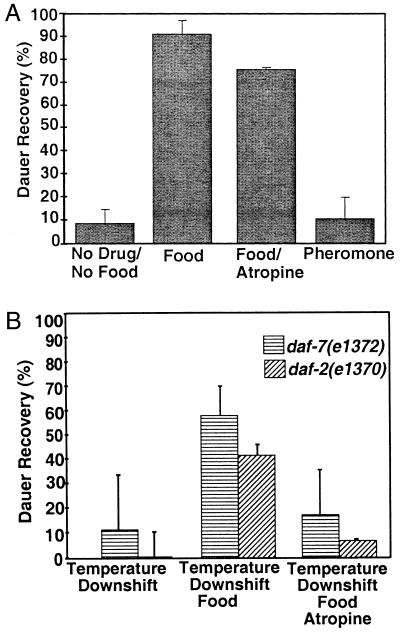Figure 2.
Atropine specifically inhibits dauer recovery in C. elegans and A. caninum. (A) Wild-type pheromone-induced dauer larvae placed on plates containing bacterial food, no bacteria and no pheromone, bacteria and 1 mM atropine, and pheromone at 25°C and scored 24–42 hr later for dauer larvae and reproductive L4/adults. Experiments were performed at least twice. With no food or pheromone, 91% of the animals remain arrested (n = 1,141). Dauer larvae placed on plates with food recovered efficiently, with less than 10% remaining arrested at the dauer stage (n = 2,596). The addition of 1 mM atropine in the presence of food partially inhibited dauer recovery: 25% remained arrested at the dauer stage (n = 1,311). Eighty-nine percent of the animals maintained on plates with pheromone but no food (n = 1,027) remained arrested at the dauer stage. The pheromone preparation contained bacterial contaminants that may have been used as a food source. In A. caninum incubated with 10% serum and 25 mM GSM, 9% of the infective larvae remained as dauer larvae and did not resume feeding. The addition of atropine (0.5 mM) to the serum and GSM completely inhibited recovery of A. caninum L3, and no worms resumed feeding (data not shown). (B) daf-7(e1372) (horizontally striped bars) and daf-2(e1370) (diagonally striped bars) dauer larvae from 25°C liquid cultures were placed onto plates at 15°C. Animals were scored for the presence of dauer larvae and reproductive adults after 2 days. Temperature downshift induced dauer recovery only very slightly in daf-2(1370) animals (4%, n = 320) and not in either daf-7(1372) (0.2%, n = 330) or daf-2(1391) animals, where 100% of the animals remained as dauers (n = 164). At 15°C with food, 65% of the daf-2(e1370) (n = 384) and 43% of the daf-7(e1372) dauer larvae (n = 587) recovered and 76% of daf-2(e1391) animals recovered (n = 458). Atropine at 1 mM potently inhibits dauer recovery of daf-2(e1370) to 18% (n = 228), daf-7(e1372) to 6% (n = 405), and daf-2(e1391) to 23% (n = 363) dauer larvae on plates at 15°C with food. For daf-2(1370) and daf-7(e1372), each experiment was performed two or three times, whereas for daf-2(e1391), the numbers are from only one trial. The difference between the effects of atropine on pheromone-induced dauer larvae and either daf-2- or daf-7-induced dauer larvae may be because the pheromone-induced dauer larvae had been arrested longer than the daf-2 and daf-7 dauer larvae. Older dauer larvae will recover when exogenous pheromone is removed, even without the addition of food, but younger dauer larvae do not (2). Alternatively, pheromone may inhibit both the TGF-β- and insulin-like-signaling pathways (and perhaps other signals) whereas daf-2 or daf-7 mutants may only decrease one endocrine signal.

